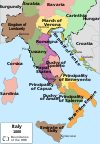Rule of the Dukes: Difference between revisions
No edit summary |
added king of italy list |
||
| Line 21: | Line 21: | ||
{{s-aft|after=[[Authari]]}} |
{{s-aft|after=[[Authari]]}} |
||
{{end}} |
{{end}} |
||
{{Antique Kings of Italy}} |
|||
[[Category:History of Italy]] |
[[Category:History of Italy]] |
||
Revision as of 05:52, 4 April 2008
The Rule of the Dukes was the decade-long interregnum from 574 or 575 which affected the Lombard kingdom in Italy after the death of Cleph. The Lombards had entered the peninsula in 568 under Alboin. Under Alboin's successor, Cleph, they continued to expand at the expense of the Byzantines. However, Cleph's reign was short and his rule hard. Upon his death, the Lombards did not elect another leader king, leaving the territorial dukes the highest authorities in Lombard territories. However, the dukes were unable to organise themselves under a single leader capable of continuing their successes against the Empire. When they invaded Merovingian Provence (584 or 585), the Frankish kings Guntram and Childebert II invaded Lombardy, took Trent, and opened negotiations with Tiberius II Constantine, Emperor of the East and nominal overlord of the hard-pressed Exarchate of Ravenna. Finally, tired of disunion, fearing a pincer action from the Greeks of the Mezzogiorno and the Franks, and lacking the leadership necessary to withstand combined military forces, the dukes elected a king, Authari. They ceded to Authari the old capital of Pavia and half of their ducal demesnes, though the fidelity to their oath with which this last promise was carried out is suspect. Authari successfully consolidated the Lombard realm against enemies on all sides throughout his reign.
Among the known reigning dukes of the times were:
- Zotto, duke of Benevento
- Vallari, duke of Bergamo
- Alagis I, duke of Brescia
- Gisulf I, duke of Friuli
- Zaban, duke of Pavia
- Faroald I, duke of Spoleto
- Euin, duke of Trent
- Aimone, duke of Turin
Sources
- Oman, Charles. The Dark Ages 476-918. London: Rivingtons, 1914.
- Paul the Deacon. Historia Langobardorum. Translated by William Dudley Foulke. University of Pennsylvania, 1907.

